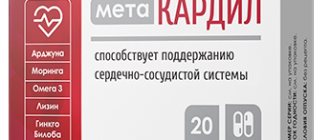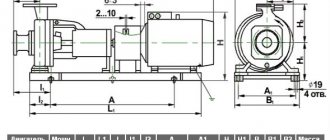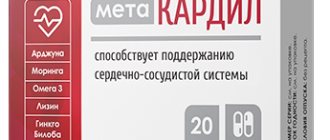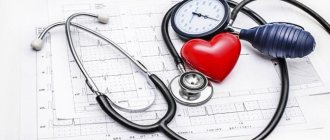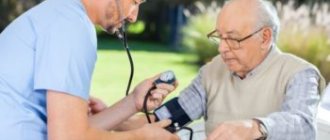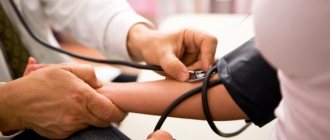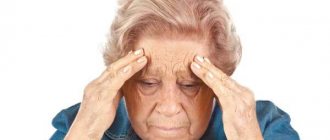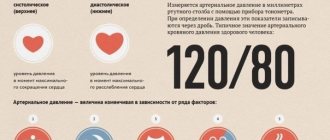14.11.2018
A.A.
(Last update: 07/10/2019)
There are contraindications. Specialist consultation required
A man lives as long as his heart beats. The myocardial muscle pumps blood from organ to organ through the circulatory system, saturating the entire body with oxygen and essential minerals, and also creating blood pressure, which is the force of lymph resistance to the walls of arteries and veins. The standard blood pressure generally accepted by the Ministry of Health is 120/80 mmHg. Art., if you do not take into account the individual characteristics of the body and a lot of auxiliary factors.
Blood pressure readings 160 to 110 mmHg. Art. may indicate stage 2 hypertension or a hypertensive crisis. If you do not relieve the symptoms and immediately call a doctor, you may end up with extremely undesirable consequences. The disease mercilessly destroys or makes disabled about a million Russians alone every year. According to statistics, hypertension, if not consulted in a timely manner, quite often leads to myocardial ischemia, strokes, heart attacks and even death.
A little about hypertension
Do not self-medicate. Consult a specialist:
Some people call hypertension the scourge of the 21st century. This is a disease characterized by increased levels of blood resistance on a chronic basis.
Pathology has several stages:
You get promotional code OZON - 300 points for your first order. OZONAPIE1I (applied in the cart)
- Arterial hypertension (short-term changes in blood pressure, indicating the onset of the disease). Pressure readings: 120-130/80-85 mm Hg. Art. This stage is still treatable.
- Mild headache (grade 1) with systolic blood pressure 140-159 and diastolic blood pressure 90-99 mm Hg. Art.
- Hypertension of the 2nd degree (160-179/100-109 mm Hg).
- Stage 3 disease (from 180/110 mm Hg).
The average person's blood pressure is 160 to 110 mm Hg. Art. indicate a hypertensive crisis at stage 2 of the disease. With higher fluctuations in blood pressure, the elevated level persists for quite a long time, and it becomes more and more difficult to stabilize it to a normal level.
Hypertension in the initial stages can occur unnoticed and, if left untreated, quickly develops into more complex forms of the disease. When the patient’s blood pressure is 160/110, the gap between the walls of the veins and arteries narrows, and the strength of blood flow, accordingly, increases. High blood pressure is typical for people over 45 years of age, when age-related changes occur in the body. However, over the past few years, cases with the onset of hypertension at an earlier age have increased significantly.
Slide captions:
Test Head contusions, concussions, traumatic shock, heart failure Part No. 8 Performed by: Deputy Director for Safety of Lyceum No. 1 Urmanov Mikhail Yurievich, VKK Komsomolsk-on-Amur 2013
8.1 Determine the sequence of first aid in case of fainting: A- spray your face with cold water; B- give the legs an elevated position; B - place the victim on his back with his head slightly tilted back; D - unfasten the collar and allow fresh air to enter. 8.2* Determine the sequence of first aid for a concussion: A- urgently call a doctor, ensure absolute rest for the victim, apply cold to his head; B- put cold on the victim’s head, give him strong tea or coffee, escort him to a medical facility; B- Give the victim painkillers and sedatives, take him to a medical facility.
8.3* As a result of the fall, the teenager developed nausea and vomiting, and coordination of movements was impaired. What is the sequence of actions to provide first aid: A- give painkillers and take the teenager to the nearest clinic or hospital; B- do a gastric lavage, give an enema, give a sedative; B- ensure rest, apply a cold compress to the head, call an ambulance. 8.4 In case of traumatic shock, first of all, it is necessary to: A- create a calm environment for the victim (exclude irritating noises), give an anesthetic; B- carry out temporary immobilization, ensure complete rest for the victim, refer the victim to a medical institution; B- eliminate the effect of the traumatic factor, stop the bleeding, give pain relief, treat the wound, apply a pressure bandage.
8.5 Sudden loss of consciousness is: A – Shock; B – Fainting; B – Migraine; G – Collapse. 8.6** The causes of heart failure can be: A- rheumatic lesions of the heart muscle, heart defects, myocardial infarction, physical overexertion, metabolic disorders and vitamin deficiencies; B - internal and external bleeding, damage to the musculoskeletal system, fatigue, heat and sunstroke; B - severe injuries accompanied by blood loss, crushing of soft tissues, crushing of bones, extensive thermal burns.
8.7** Signs of a concussion A - short-term loss of consciousness, vomiting, loss of memory for events preceding the injury (retrograde amnesia), headache, dizziness, tinnitus, unsteady gait, dilated pupils; B- short-term loss of consciousness, headache, dizziness, sleep disturbance; B- headache, vomiting, dizziness, sleep disturbance; 8.8* Main causes of traumatic shock A - overwork, overload, blood loss; B- pain, large blood loss, intoxication due to the absorption of decay products of dead and crushed tissues, damage to vital organs with disruption of their functions B- pain, blood loss, intoxication due to the absorption of alcohol breakdown products, damage to vital organs.
8.9 Normal blood pressure is A- 120/60 mm. rt. Art.; B - 140/80 mm. rt. Art.; B - 130-120/80 mm. rt. Art. 8.0 If the blood pressure is 160/110, the patient is prohibited A - to drink tea, coffee; B- lie on a soft bed; B- drink cranberry juice.
Answers: 8.1-B, D, A, B 8.2-A 8.3-B 8.4-B 8.5-B 8.6-A 8.7-A 8.8-B 8.9-B 8.0-A
Scores: “5”-10-9 points “4”-8-7 points “3”-6 points
Correlation of hypertensive crisis with blood pressure 160/110
HA is a sudden increase in blood pressure to a critical level. The patient’s condition at this moment is at risk and requires immediate professional intervention. The crisis can last up to several hours and is accompanied by a feeling of fear of death and increased panic in the patient. In grade 2 hypertensive patients, these symptoms include speech impairment, loss of the sense of touch, convulsions and fainting, pain in the heart, inhibition of behavior and consciousness. Blood pressure indicators during a hypertensive crisis are purely individual for each person. If you focus on systolic pressure, someone may experience a crisis at a value of 130, and for others it may be at least 190.
A hypertensive crisis develops as sharply as possible; the values on the tonometer dial rise quickly, along with an increase in symptoms. There is a certain group of organs that suffer from increased blood pressure first and foremost. The target organs are the heart, kidneys, brain and eyes.
The main criteria for a dangerous condition include a sudden increase in pressure to a critical level and symptoms associated with dysfunction of target organs. HA entails a greater risk of more serious pathologies.
In most cases, GC exclusively targets hypertensive patients. But sometimes the condition can overtake a healthy person after experiencing stress, too much alcohol or other factors.
GK can occur in a complicated or uncomplicated form.
Uncomplicated GC
This type is characterized by serious dysfunction of target organs:
- Cardiac – malfunction of the myocardium. The crisis is accompanied by a lack of oxygen and pain in the heart muscle.
- Brain is characterized by dysfunction of the brain. May be accompanied by dizziness, headache and other symptoms.
- A crisis with increased diencephalic syndrome, in which the patient feels tremors and numbness of the limbs, redness of the skin, increased sweating, headaches, fever, etc.
The main cause of hypertension is non-compliance with the treatment prescribed by the doctor for hypertension or its complete absence. In rare cases, GC can occur in a person after surgery or who has suffered severe burns.
Complicated HA
This type is distinguished not only by high levels of SBP and DBP, but also by acute dysfunction of risk group organs (targets). If in this case the pressure is not reduced to normal levels in at least an hour, detrimental and life-threatening consequences may occur.
Namely:
- Brain hemorrhage or acute neuronal damage;
- Brain or myocardial infarction;
- Swelling of the respiratory system;
- Aortic detachment;
- Renal dysfunction.
An increase in blood pressure is not always directly related to possible complications. Serious disturbances can occur even with a systolic reading of 140, and in some cases a reading of 200 does not cause any consequences in a person.
What does 160/110 mean?
Blood pressure 160/110 indicates that the patient has grade 2 hypertension, which occurs in a moderate form. Often the disease is accompanied by an excessive increase in systolic blood pressure (BP), which is extremely difficult to treat.
Arterial hypertension is dangerous due to its rapid, rapid development, numerous consequences and complications. Sharp surges in pressure 160/110 are accompanied by narrowing of the lumens of blood vessels, increased blood flow, disturbances in circulatory and microcirculation processes.
The patient has a disorder in the functioning of the cardiovascular system. With persistently elevated pressure, the blood vessels themselves are constantly in spasm, which is fraught with the development of a stroke or heart attack.
Blood pressure 160/110 is dangerous to health and life
Reasons and patterns
As is known, the generally accepted norms for blood pressure differ from the working pressure of each person. Someone may feel normal with a chronically low tonometer value, while others, on the contrary, may feel normal with a high value (but not more than 139/89 mm Hg). A blood pressure reading of 160 to 110 in men and women indicates at least stage 2 hypertension, which requires mandatory drug therapy, the formation of correct eating habits, lifestyle changes, etc.
Hypertension has an extremely negative effect on the cardiovascular system, leading the body to narrowing of blood vessels and damage to their walls. When the blood flow is strong enough, the walls of the arteries and veins burst from the powerful pressure, causing hemorrhage in the organ where the damaged capillaries are located.
Causes of high blood pressure:
- Uncontrolled consumption of alkaloids and other drinks that affect the state of the cardiovascular system. These include strong hot tea and coffee, as well as energy drinks, which contribute to more intense production of adrenaline, which leads to an increase in blood pressure. If you do not control the frequency of consumption and the number of drinks in this category, headache can develop from a mild stage into a chronic form.
- Physical inactivity. A sedentary lifestyle is fraught with more than just obesity. An organism that is accustomed to constantly sitting at work or at home, with the slightest physical activity, can signal its overwork with factors such as increased heart rate and increased blood pressure.
- Pyelonephritis and other pathologies of the kidneys and adrenal glands. The slightest dysfunction of these organs, which are responsible for removing excess fluid, toxins, waste products and half-life products, for obvious reasons, negatively affects blood flow.
- Increased “bad” cholesterol in the blood contributes to the growth of lipid plaques on the walls of blood vessels, which reduces the lumen and interferes with normal blood flow. Blood presses on the walls of veins and arteries, which are not able to provide lymph with a normal “corridor” for circulation, as a result of which blood pressure rises.
- Stressful situations. Any stress experienced, including after an injury, may well provoke changes in blood pressure if a person is predisposed to increased blood pressure. This is especially dangerous in the presence of cardiovascular diseases. In such cases, the slightest worry or tension in the central nervous system can provoke a critical condition of the patient.
- Withdrawal syndrome. If you abruptly stop taking antihypertensive or sedative medications, your blood pressure level may rise sharply, leading to a hypertensive crisis.
- Wrong diet. An imbalance in the menu can also cause high blood pressure. For example, consuming large amounts of salt contributes to the occurrence of edema, fluid retention in the body and increased blood pressure.
- Heredity may be a fundamental factor in the development of arterial hypertension and increased blood pressure.
- Acclimatization. Climate change can also lead to changes in blood pressure.
- Causes of unknown origin. As a rule, this refers to essential hypertension, which is characterized by unstable changes in blood pressure without specific causes. A person may even have factors predisposing them to hypertension, such as bad habits or obesity, that are not the cause of hypertension.
- Self-medication may also be one of the reasons. If, for hypertension, the attending physician has prescribed therapy for the patient with the necessary drugs and dosage, and the patient voluntarily changes the medications to cheaper analogues or their quantity at one time, this can lead to a dangerous outcome. You should also not add additional medications to the prescribed medications without the knowledge of the attending physician. Incompatibility of medications can have a detrimental effect on the patient’s health.
In the fair half, the disease most often appears due to obesity, pregnancy, menopause, menopause, or taking hormonal medications.
Why is blood pressure 160/100 or higher dangerous?
Optimal blood pressure is individual for each person and corresponds to indicators from 100/60 to 140/90 units. Blood pressure of 160 over 100 or 110 is second-degree hypertension. It requires correction with the help of medications; it cannot be left unattended, as this threatens the development of many life-threatening complications.
The essence is myocardial ischemia due to vascular spasm as a result of an increase in their tone under the influence of biologically active mediators or hormones. The most serious danger is sudden cardiac arrest.
In addition, potentially fatal complications are likely:
- hypertensive crisis;
- dissecting aortic aneurysm or rupture;
- pre-stroke, stroke (ischemic or hemorrhagic stroke);
- pre-infarction, heart attack;
- acute heart failure;
- chronic renal failure;
- dementia, dementia
Long-term hypertension is dangerous due to the formation of malignant hypertension; the addition of tachycardia over 100 beats/minute indicates a possible fatal outcome.
Risk factors
Increased blood pressure can be caused by the following risk factors:
- Chronic form of any disease;
- Progressive vascular atherosclerosis;
- Diabetes;
- Metabolic disorders;
- Heart failure;
- Disruptions in the endocrine system and thyroid function;
- Infectious and viral diseases;
- Hypothalamic lesions;
- Hormonal disorders;
- Long-term use of certain medications;
- Insomnia or other sleep disorders and fatigue.
Blood pressure of 160 to 110 in men can occur due not only to age-related changes, but also to the harmful effects of bad habits and obesity.
Symptoms
In addition to high blood pressure readings on a tonometer, second-degree hypertension can be recognized by the symptoms that all patients experience. The main symptom of this pathological condition is pain in the back of the head and tinnitus. Some people complain of spots in front of their eyes, which significantly reduce their vision and make it difficult to concentrate.
Other symptoms indicating a blood pressure of 160 to 110 include:
dizziness;- nausea;
- soreness in the chest area;
- decreased performance;
- apathy;
- numbness of the limbs;
- convulsions;
- difficulty pronouncing words;
- swelling of the face;
- increased sweating.
The clinical picture may differ for each person. If symptoms become more intense or appear more intense, you should call an ambulance.
What can it lead to?
If the pressure has risen to a critical level of 160 to 110, few people know what exactly this means. Stage 2 hypertension or hypertensive crisis without proper therapy can lead to much worse consequences.
Namely:
- Cardiaortic aneurysm;
- Atherosclerosis and cerebral thrombosis;
- Organic damage to the brain;
- Angina pectoris.
Increased pressure primarily has a detrimental effect on target organs:
- Heart muscle and cardiovascular system;
- Kidneys and adrenal glands;
- Brain and hypothalamus;
- Visual organs.
If no measures are taken to lower blood pressure and treat the disease, over time, irreversible destructive changes occur in the target organs with subsequent dysfunction.
For men, an increase in pressure to a critical level is fraught with frequent heart attacks, strokes, impaired visual function and problems with potency.
During pregnancy, pressure changes are commonplace, but they cannot be ignored. If symptoms are not stopped in time, temporary hypertension can develop into a chronic form and negatively affect the unborn child.
Reasons for this pressure
When they first see the numbers 160 by 110 on a tonometer, many do not understand what this means and do not know whether treatment should be started. Naturally, first of all you should consult a doctor. Hypertension can be triggered by severe stress or intense physical activity. If a jump in blood pressure is observed once, further therapy may not be required, but if the situation repeats and the pressure does not drop, you need to sound the alarm.
In people of retirement age, the main reason for the development of hypertension is the natural thinning of blood vessels and loss of their elasticity. The young population has physical inactivity.
If you often eat unhealthy foods, cholesterol plaques form on the walls of blood vessels. They narrow the lumen and disrupt normal blood flow.
Both causes provoke vascular spasm, and blood enters the heart, brain, kidneys and other vital organs in insufficient portions, which leads to oxygen starvation. And without oxygen, organs begin to die and the person dies.
And also read on our website: What do blood pressure readings of 100 to 80 mean, for whom are they considered normal, and why do you feel nauseous and have headaches?
High blood pressure occurs at least once in every person's life. There are trigger factors that can increase the likelihood of developing the disease. In medicine they are divided into two groups:
| adjustable | obesity bad habits poor nutrition incorrect daily routine |
| uncorrectable | age hereditary disposition diabetes mellitus, etc. |
In addition, very often hypertension develops against the background of:
- hormonal imbalances;
- disruption of the endocrine system;
- pathologies of the kidneys and adrenal glands;
- head injuries and hypothalamic diseases;
- atherosclerosis.
The risk of developing second-degree hypertension is increased by lack of sleep, frequent stress, a sedentary lifestyle, as well as abuse of salty foods and caffeine.
It will be interesting to know that a pregnancy that has complications can lead to a malfunction of the heart.
Symptoms of pressure 160/110
The main manifestation of this disorder is cerebral vascular spasm and, as a result, headache. Blurred vision, ringing in the ears, dizziness, weakness and increased heart rate are the primary signs of increased blood pressure.
Along with these symptoms, the patient may experience:
- Pulsation in the head;
- Nausea and vomiting;
- Fainting;
- Shock;
- Redness of the skin and swelling of the face;
- Excessive sweating;
- A life-threatening condition due to a decrease in the tone of the vascular walls;
- Numbness and loss of sensation in the limbs;
- Disorders of target organs.
All these symptoms may indicate a hypertensive crisis or an ordinary increase in blood pressure.
Are such indicators dangerous?
Advanced second-degree hypertension is dangerous for the development of heart attack and stroke.
A constant increase in blood pressure leads to renal failure, blurred vision, cerebral thrombosis, aortic aneurysm, angina pectoris and encephalopathy. Hemorrhage may occur in vital organs, as the walls of the vessels feeding them lose their elasticity. However, if treatment is started in time, pathological changes can be prevented. The main thing is not to hesitate, because the count is not in months, and not even in days, but in minutes.
What to do if the pressure rises to 160 to 110
If there is a systematic increase in blood pressure, the patient is first recommended to say goodbye to bad habits, give up excessive physical activity (if any) and strictly follow the doctor’s instructions.
If there is a sudden increase in pressure to 160 to 110 or higher before the ambulance arrives, you can alleviate the person’s condition and reduce resistance as follows:
- Fully open the windows in the room;
- Unbutton the top button of the victim's shirt;
- Sit the patient so that he is in a relaxed position;
- Place the victim’s feet in a basin of warm water;
- Place a piece of antihypertensive tablet under your tongue.
If for some reason the arrival of an ambulance is delayed or delayed, the patient’s blood pressure should be measured every half hour before giving the next mini-portion of the antihypertensive drug. When blood pressure levels stabilize, use of the medication should be stopped so as not to lower the blood pressure to a critical level.
Main reasons for development
Symptomatic hypertension is observed in chronic diseases of the kidneys, thyroid gland, blood vessels and myocardium.
The predominant increase in diastolic indicator is associated with high arterial spastic activity that occurs when the following organs are affected:
What to do if the pressure is 150 to 70
- Dysfunction of the periglomerular apparatus. Causes excess production of biologically active substances that provoke vascular spasm. As a result of the influence of vasospastic hormones, the tone of the smooth muscles of the arteries increases and the vascular lumen decreases. These pathologies include (glomerulonephritis, atherosclerosis of the renal vessels, nephropathy).
- Excessive production of thyroid hormones. The production of large amounts of thyroid-stimulating hormones provokes pronounced activity of the sympathetic nervous system. This serves as a provocateur of afferent stimulation of the vascular center in the medulla oblongata, which is expressed in the formation of arterial spasm.
- Increased circulating blood volume. It is observed when the activity of the renal tissue is impaired, when sodium and fluid retention occurs. It is registered against the background of endocrine dysfunction, manifested by fluid retention, which leads to hypervolemia.
An increase in blood pressure values against the background of cardiac and vascular pathologies is referred to as hemodynamic secondary hypertension. Its formation is caused by atherosclerotic processes in the aorta, some heart valve defects, chronic heart failure, and severe disorders of myocardial contractile activity. Atherosclerotic damage to regional vessels leads to a disorder of the heart rhythm, as a result of which the myocardium does not relax enough in the diastole phase.
Provoking factors include:
- genetic predisposition;
- men over 40 years of age;
- women over 50 years of age;
- lipid and carbohydrate metabolism disorders;
- excess body weight;
- excessive consumption of sodium chloride;
- sedentary lifestyle;
- bad habits;
- low resistance to stress.
No ads 2
Kidney factor
The kidneys ensure the maintenance of normal blood pressure levels. When they are damaged, pressure levels increase, and they are also the target organ for essential hypertension. Secondary hypertension of renal origin is associated with damage to the vessels of the organ; thus, renovascular and renoparenchymal forms are distinguished.
With the renovascular form, the pressure of blood flowing into the vessels of the kidneys decreases, as a result of which mechanisms aimed at restoring blood circulation are activated, which leads to excess production of renin. This provokes an increase in vascular tone, their spasm, as a result of which the pressure level increases. In the clinical picture, the disease is manifested by an increase in the predominantly diastolic indicator, resistant to antihypertensive therapy.
Renoparenchymal hypertension is the most common type of pathology, developing as a result of chronic glomerulonephritis, pyelonephritis, and infection of the excretory system. In the clinical picture, high blood pressure is combined with characteristic renal symptoms such as swelling, pain in the lumbar region, and urinary disorders.
Important! A pressure of 150 to 120 may correspond to the renal form of the pathology, when the diastolic value increases significantly, and endocrine metabolic disorders provoke a proportional increase in the systolic value.
Treatment of hypertension with pressure 160/110
Recommendations for therapy, after a complete examination of the patient, are given by the attending physician who prescribes a specific type of treatment. Stage 2 hypertension cannot be treated without pharmaceutical products, so regular and systematic use of medications is mandatory. The doctor prescribes medications and dosage based on the medical history and individual characteristics of the patient’s body.
As a rule, funds from the following groups are prescribed:
- Preparations with diuretic properties to remove excess fluid and reduce swelling;
- Alpha blockers to increase the clearance between the walls of arteries and veins;
- ACE inhibitors, which normalize the functioning of the heart muscle and prevent vascular spasms;
- Antihypertensives and sartans, which reduce blood pressure for 24 hours after taking the tablet;
- Beta blockers that normalize heart rate;
- Calcium channel blockers, which improve the patency of arteries and veins, which helps reduce blood pressure;
- Sedative (calming) drugs.
If you miss a pill, doubling the dosage the next time you take it is strictly prohibited!
Daily use of medications prescribed by a doctor is only part of the success on the path to recovery. In addition, the patient should protect himself as much as possible from stress and anxiety, get enough sleep and not overwork.
Nutrition and lifestyle
Do not forget that complex treatment can be effective if all prescriptions are followed, including not only drug therapy, but also lifestyle, physical activity, diet and sleep, etc.
The food you eat plays a significant role in the treatment of the disease. If you take antihypertensive drugs and at the same time eat foods that increase blood pressure, you can get into a vicious circle of unsuccessful treatment.
In order for therapy to bring only benefits, it is better to revise the diet a little, replacing junk food with healthy ingredients. For example, you should exclude fatty, fried and smoked foods, fresh baked goods, baked goods, confectionery and pickles. You will have to forget about strong coffee and tea in favor of weakly brewed, non-hot drinks. It is recommended to reduce the consumption of salt, sugar and spices as much as possible. Allowed for hypertension are low-fat meat and dairy products, vegetables and fruits, legumes and cereals, herbs and berries, as well as seafood rich in iodine and B-vitamins.
Products such as mayonnaise should be treated with caution. It is better to replace it with the same home-made product, removing the unhealthy ingredients in it and adding acceptable ones from the menu.
It is better to prepare dishes for hypertension by steaming, in a microwave oven, in the oven or by boiling. Baking on a grill or barbecue is allowed. It is better to avoid fried foods. If you really want it, you can treat yourself to the same fried potatoes, but only occasionally and using a small amount of oil.
Diet is an important component of effective therapy. If you have hypertension, you need to eat strictly following the nutritionist’s instructions and creating a balanced menu. Meals should be regular, with an interval of 3-3.5 hours, but portions should be small - no more than 300 g of the total portion weight. At the same time, you should not load your body with excessively high-calorie food immediately after sleep. Dinner should be light, no later than 1.5 hours before evening rest.
It is also important to follow a drinking regime, drinking 1.5 - 2 liters of clean still water daily. Water circulates through the bloodstream and promotes improved absorption by the body of all beneficial substances coming from food.
Hypertension is often accompanied by obesity, so lifestyle changes when treating the disease are aimed not only at stabilizing blood pressure levels, but also at reducing weight. The correct lifestyle consists of daily physical activity, the level of which is determined by the attending physician. This could be just walks in the fresh air, morning exercises, or training with a limited degree of stress on the heart muscle.
Treatment
To normalize a person’s standing, doctors prescribe complex therapy for hypertension. The list of necessary medications includes drugs from the following groups:
ACE inhibitors - dilate arteries and relieve spasms in blood vessels;- calcium antagonists - normalize heart function;
- alpha and beta blockers - stabilize heart rate and dilate blood vessels;
- diuretics - reduce fluid levels in the body;
- sedative medications - stabilize the functioning of the nervous system.
And also read on our website: What do blood pressure readings of 110 over 90 mean and what to do with them, as well as the causes and pulse values
Among antihypertensive drugs, Bisoprolol, Artil and Lisinopril have a good effect.
Veroshpiron, Furosemide and Thiazide are recommended for use as diuretics.
Atorvastatin is prescribed to lower blood cholesterol levels.
Aspecard can be used to thin the blood.
ACE inhibitors will help relieve spasms: Captopril, Enalapril, Fosinopril.
Beta blockers such as Acebutolol, Pindolol, Propranolol and Timolol occupy not the least place in therapy.
The patient is prohibited from choosing his own medications. The treatment regimen is developed by the doctor. He takes into account the specifics of the medicine and selects drugs in such a way that they complement each other and have a complex effect on the body.
In order for the treatment to give the expected result, you need to take the medications strictly on an hourly basis and adhere to the dosage recommended by the doctor.
Folk remedies
The use of traditional medicine as the main method of treating hypertension is strictly prohibited. At the same time, by supplementing synthetic medications prescribed by a doctor with medicinal herbs, you can achieve recovery much faster.
The following recipes help stabilize blood pressure:
- Dried herbs of motherwort, cudweed, horsetail and valerian are mixed in equal quantities and brewed for 15 minutes. Take 50 g before each meal.
- A decoction of mint, buckthorn and yarrow helps stabilize heart rate and blood pressure surges caused by physical activity and stress. The prepared herbal decoction is consumed instead of tea three times a day.
- Chokeberry leaves are poured with boiling water and infused in a thermos. When the broth has cooled, add dill seeds and leave for another half hour. Strain the product and drink 100 g on an empty stomach.
Parsley has a very good effect on the body of hypertensive patients, because it is able to cleanse blood vessels and stabilize the functioning of the heart. Eating parsley is beneficial in any form, both natural and dried.
Nutrition
To help the body fight surges in blood pressure, you need to eat right.
Increase the amount of dried fruits in your diet - this is a real storehouse of vitamins. Garlic, celery and asparagus will cleanse the body of toxins and strengthen vascular walls. Useful minerals can be obtained from cottage cheese, whole grain cereals, as well as fresh fruits and vegetables.
And also read on our website: Blood pressure 120 over 100: causes, symptoms, what does it mean and what to do with such indicators?
Try to eat light foods, give preference to liquid dishes and steamed foods. It is very important to limit the amount of fatty foods, preserves, sweets and smoked foods.
Avoid alcoholic drinks, soda and fast food. They contain large amounts of cholesterol, which is one of the main provocateurs of vascular diseases.
The worst effects on the condition of blood vessels and heart function are salty foods and caffeine.
Folk remedies for adjuvant therapy
Properly selected natural supplements of plant origin can enhance the general therapeutic effect of medications taken and bring additional benefits to the body.
So, for hypertension it is recommended:
- Use herbal decoctions and infusions instead of tea;
- Add vegetable broths and juices to your diet;
- Do not forget about such healing ingredients as hawthorn, viburnum, honey, garlic and cranberry.
Medicinal herbs for herbal medicine should be selected by the attending physician who knows the characteristics of the body, the course of the disease and the patient’s medical history.
For decoctions, it is better to use not a specific plant, but herbal infusions, which may include lingonberries, rose hips, lemon balm, mint, calendula, magnolia, wormwood and clover. The above herbs relieve spasm of veins and arteries, improve myocardial function and calm the body.
Physiotherapy
Warm baths for the feet or the whole body will not harm, but rather will improve the patient’s condition. It is best to carry out the procedure in the evening. You can add herbal infusions, essential oils or emulsions to a container of water. Swimming in warm water before evening rest will eliminate nervous tension, reduce tone, improve the quality of sleep and overall well-being.
The average duration of the procedure is 15-20 minutes. After swimming or a foot bath, it is recommended to dress in warm clothes and take a horizontal position, ideally for the whole night.
Hypotensive massage
This procedure can be performed by anyone. The total duration of the therapeutic massage is 10 minutes.
Professional skills are not important here, the main thing is to follow a certain sequence:
- Therapeutic massage should begin with the neck and shoulders, lightly stroking and rubbing, without much zeal.
- Next, add light pressure to the neck area while stroking.
- After the neck comes light stroking of the upper chest (at the level of the upper 7 vertebrae).
- The final stage will be kneading the pain points in the back of the head, as well as the crown, temples and frontal part.
Hypotensive massage can have a vasodilating effect. Soft stroking calms the central nervous system, helps reduce spasm and tension in the arteries and veins, as a result of which blood pressure decreases.
Do they give you disability?
With persistent blood pressure readings at 160/110, disturbances in the body and dysfunction of vital organs are inevitable. When conducting a full examination of the patient and a medical examination, the medical commission may assign a person a disability group of 3 if damage to internal target organs is detected. When a patient is assigned a disability, he is obliged to adhere to the rehabilitation scheme prescribed by doctors.
The third disability group does not exempt you from work, however, it has its limitations:
- There should be no noise in the workplace;
- A person should not experience frequent stress due to work and various types of stress;
- The patient definitely needs to reconsider his work schedule, eliminating irregular working hours and night shifts;
- A hypertensive disabled person is not allowed to concentrate too high when performing certain tasks: the load on the brain should be moderate;
- Also, patients with hypertension are prohibited from working at high altitudes.
In some cases, a person with hypertension may be assigned disability group 2, which imposes a ban on work. Only home work is permitted.
The first disability group is assigned in rare cases of severe progression of the disease, severe heart failure, serious dysfunction of internal organs and complete loss of self-care skills.
The presence of a disability group requires its annual confirmation.
Prevention measures
To avoid being caught off guard by headaches, it is better to keep your finger on the pulse by regularly taking preventive measures and monitoring your condition.
One of the mandatory preventive measures is the formation of correct eating habits. Eliminating salt, fast food, sugar and fat with alcohol in exchange for healthy food will be beneficial not only to a person with a predisposition to hypertension, but also to a healthy body.
Walking in the fresh air with breathing exercises instead of smoking will strengthen the heart muscle and respiratory organs, help cleanse the lungs, and saturate the body with oxygen.
Moderate physical activity accelerates the blood, gradually eliminates fatigue and shortness of breath, and is also a preventive measure against obesity.
If a person is being treated for arterial hypertension at the initial stage, then in most cases, compliance with preventive measures in combination with the use of some unconventional methods allows you to forget about pressure drops forever, even without taking medications.
Correcting hypertension at home
Home help for relief of high blood pressure is differentiated.
First aid
If the pressure reaches 160 over 100 or 110 and continues to rise, an ambulance must be called, especially if a person experiences the following symptoms:
- severe burning pain behind the sternum;
- fear of death;
- profuse sweat;
- dyspnea;
- tachycardia
Otherwise, you may develop a heart attack or stroke with unpredictable consequences. In other cases, the main task is to achieve a decrease in SBP/DBP within the first hour after its rise. Before the doctors arrive:
- half-lay the person on high pillows;
- provide a flow of fresh air;
- calm the patient;
- ask to breathe shallowly, evenly;
- give 20 drops of sedatives - Corvalol;
- if there is a treatment regimen developed by the doctor earlier, follow the instructions;
- on the calves - mustard plaster, on the feet - a heating pad, under the tongue - a Nitroglycerin tablet;
- regular tonometry.
All actions are recorded and transmitted to the doctor.
Drug therapy
Blood pressure of 160 to 100 or higher can only be corrected with medications. It is reduced gradually; an overdose of drugs or an incorrectly selected drug can sharply reduce blood pressure to critical levels. Use:
- diuretics: Hypothiazide, Indapamide, Lasix, Spironolactone, Veroshpiron - remove excess fluid from the body, facilitating the functioning of the heart and blood vessels;
- antispasmodics – Spazgan, Maksigan, Scopolamine, Spanil, Platyfillin – relieve spasm of the arteries;
- hypotensive - Norvasc, Amlodipine, Renitek, Ko-Renitek, Concor - affect the body's enzyme systems, metabolic processes, and nervous system in various ways, normalizing blood pressure.
The doctor chooses the treatment regimen. Spontaneous administration of drugs is prohibited.
Folk recipes
Hypertension of the second degree allows the use of folk recipes as a background:
- Flax seeds contain large quantities of essential omega-3 fatty acids, which rejuvenate blood vessels and increase their elasticity. The body cannot synthesize these substances on its own; they must constantly be supplied to it through food. The recipe for treating hypertension is simple: grind the seeds in a blender and add them to salads, main courses, and sprinkle on sandwiches. By including flax seeds in your diet, you can extend your life by an average of 5 years;
- tincture of red pine cones is used not only to treat hypertension, but also after a stroke, to normalize motor function in case of partial paralysis: the raw materials are collected in June-July, washed, poured into a liter jar, then poured with vodka or alcohol, infused for a couple of weeks in the dark at at room temperature, filter, drink three times a day, half an hour before meals, a teaspoon;
- garlic is a folk remedy for the treatment of high blood pressure, two cloves of garlic are crushed, poured with a glass of boiled water, and left for 12 hours. Drink a glass of garlic water in the morning and evening. The course of treatment is a month;
- Unpeeled pumpkin seeds in a half-liter jar are boiled for two hours, cooled and drunk throughout the day;
- A glass of cucumber juice taken in the morning on an empty stomach helps remove toxins from the body and reduces vascular tone.
All prescriptions must be approved by your doctor.
Summing up
When the pressure rises to 160 to 110, if nothing is done or taken, the patient’s condition can be brought to a critical point, fraught with serious complications and even death. A hypertensive crisis is a very serious peak human condition that requires emergency care and prompt consultation with a doctor. Ignoring regularly occurring symptoms, such as headache, numbness of the hands, nausea, etc., can lead a person to an advanced form of the disease. In order not to wait for extremes, it is better not to forget about disease prevention. Weight control, healthy food, walks and feasible physical exercise, normal rest, adequate sleep and regular measurement of blood pressure and pulse will prevent such a terrible disease as hypertension from appearing or developing. And compliance with all doctor’s instructions in combination with physiotherapeutic procedures and non-traditional recipes will help prolong life for several decades, even with a severe form of the disease.
